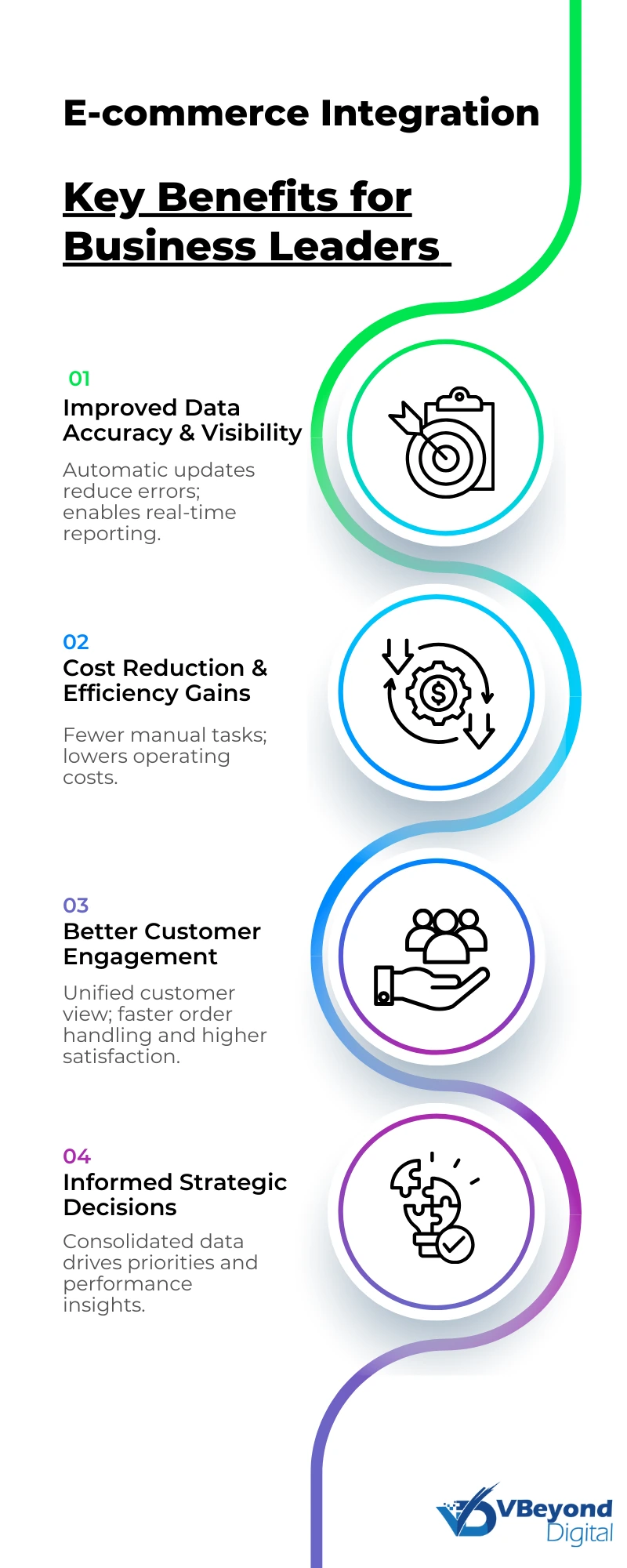Integrating Dynamics 365 Business Central with E‑Commerce Platforms
Section
- Dynamics 365 Business Central and e-commerce platforms share orders, inventory, and customer records in real time, removing data silos.
- You can connect them via REST APIs, native connectors, Power Automate flows, or third-party middleware.
- Synced systems cut manual entry, shorten order-to-cash cycles, and ensure accurate reporting of online stock levels for better customer satisfaction.
- Success relies on a thorough audit, phased rollouts with testing, and role-based training on new processes and security.
In 2023, 49.9% of European enterprises ran ERP, CRM, or BI systems, underscoring the importance of unified data platforms in daily operations. Yet 34% of companies still report stock-outs caused by outdated inventory on customer-facing sites, directly impacting revenue and customer trust. Integrating ERP with e-commerce can cut operational errors by 20–30%, saving an average of $1.5 million annually on manual corrections and reconciliations.
Enterprise resource planning (ERP) systems like Dynamics 365 Business Central unify critical business functions—financial management, inventory control, order processing and customer data—into a single database, giving leaders a clear view of operations. E-commerce platforms handle storefront design, payment processing and digital marketing, serving as the face of customer interaction. When these systems run independently, organizations face duplicated effort, inconsistent data and slower response to market demands.
This article is designed for senior technology and product executives—CEOs, CMOs, CIOs, CTOs and transformation leaders—seeking a clear roadmap to integrate Business Central with online sales channels. We’ll cover integration mechanisms, executive benefits, common obstacles and strategic best practices, all backed by real-world examples.
Current Business Challenges
- Data Silos and Manual Workflows: As e-commerce volumes grow, manually entering orders into an ERP becomes untenable, driving up labor costs and error rates.
- Inventory Inconsistencies: Without connected systems, inventory levels on your website can lag in showing real stock counts, leading to stock-outs or overselling—and eroding customer trust.
- Complex Technical Alignment: Bridging APIs, data models and deployment environments often require specialized integration expertise and robust change management to mitigate downtime and governance risks.
Overview of Dynamics 365 Business Central and E-Commerce Platforms
Dynamics 365 Business Central centralizes financial operations—managing receivables and payables, registering transactions, reconciling bank accounts, and handling vendor payments and expense reimbursements—all within a single ERP environment.
It offers built-in inventory management through item cards that track on-hand quantities, allow physical counts, and post adjustments to item ledger entries for accurate stock control. Sales and order processing is supported via a native sales order module: you can create ship, invoice and post orders without leaving the platform, preserving audit trails and accelerating cash flow. Beyond individual modules, Business Central delivers role-tailored workspaces and out-of-the-box integration with Power BI—giving leaders real-time dashboards fed by unified data across finance, supply chain and sales.
E-Commerce Platforms in Use
Leading online storefronts support comprehensive catalog management, secure payment handling, promotional pricing, tax and shipping configuration, and customer account features.
- Shopify: Offers an integrated payment gateway that automatically accepts all major payment methods as soon as you launch, eliminating third-party setup.
- Adobe Commerce (Magento): Provides lightning-fast storefronts, real-time personalization and a flexible development framework for custom modules and headless implementations.
- WooCommerce: Includes WooPayments for both online and in-person payments, with full revenue tracking and payment reconciliation directly in the WordPress dashboard.
Streamline ERP and
E-commerce now
Integration Mechanisms
- RESTful APIs: Business Central exposes a versioned REST API (v2.0) that allows external systems to read and write entities such as customers, sales orders, items and inventory counts, once Entra ID authentication is enabled.
- Native Connector: A dedicated Shopify connector within Business Central guides you through pairing your store, mapping data fields, and scheduling automatic imports of orders, products and customers—turning e-commerce inputs into posted sales orders in Business Central.
- Power Platform Flows: Through the Dynamics 365 Business Central connector in Power Automate, you can build custom flows that trigger new web orders, push inventory updates, or sync invoice statuses—extending integration logic without custom code.
- AppSource and Middleware: Third-party e-commerce connectors on AppSource offer configurable buffer tables to stage webstore data (orders, returns, shipment statuses) before committing to Business Central sales and warehouse entries.
Data Synchronization Patterns
The typical information flows include:
- Order Ingestion: E-commerce orders (customer, items, quantities, shipping) post to Business Central as draft sales orders.
- Inventory Updates: On-hand quantities are pushed back to the storefront to prevent overselling.
- Customer Master: New customer accounts created online sync to Business Central customer records for unified CRM.
- Pricing and Catalog: Item descriptions, pricing tiers and promotions defined in Business Central can propagate to the online catalog via API or connector mappings.

Key Benefits for Business Leaders
ERP-integrated e-commerce platforms push real-time on-hand quantities back to your website, preventing oversells and stock-out situations that damage brand trust. When Business Central workspaces and Power BI dashboards draw from unified sales and inventory data, leaders gain a single pane of glass for monitoring order fulfillment rates, margin impact and supply-chain bottlenecks.
Cost Reduction and Efficiency Gains
Automating order imports and inventory adjustments frees IT teams from tedious data-entry tasks, reducing related labor costs by roughly 20% in many deployments. Organizations report order-to-cash cycle times accelerating by as much as 25% once orders flow automatically from e-commerce into ERP, speeding up invoicing and cash application. By eliminating batch exports, spreadsheet reconciliations and manual vendor payments, companies lower their total cost of ownership for both ERP and e-commerce platforms.
Better Customer Engagement
With accurate, up-to-date inventory visible online, backorders and cancellations drop, improving on-time delivery rates by approximately 15% and boosting customer satisfaction. Integrated shipping configuration lets customers pick from multiple carriers and real-time rates—supporting faster delivery choices and fewer surprise fees at checkout. Unified customer records—combining purchase history, support tickets and payment data—empower service teams to resolve inquiries in one interaction, elevating Net Promoter Scores and repeat purchase rates.
Informed Strategic Decisions
Consolidated sales, inventory and customer data enable what-if analyses for promotions, seasonality and supply-chain shifts—so you can model margins before committing. Executive dashboards in Business Central, refreshed by live e-commerce feeds, give CIOs and CTOs the ability to forecast working capital needs and adjust procurement plans within hours, not days. Real-time visibility into product performance empowers product heads to identify low-velocity SKUs, reprice dynamically or pull underperforming items—maximizing revenue per square foot of inventory.
Challenges and Considerations
Technical Complexity
Integrating Dynamics 365 Business Central with an e-commerce platform demands deep expertise in both systems’ APIs, data schemas and authentication flows. Bridging compatibility gaps between legacy ERP customizations and modern storefront extensions often requires custom middleware or bespoke connectors, driving up engineering overhead. Version mismatches—such as moving from Business Central API v1.0 to v2.0—can break existing workflows unless a clear versioning strategy is in place. Common connector errors (for example, with Popdock or AppSource plug-ins) demand detailed logging and frequent update cycles to maintain stability. Many organizations must engage external consultants or train internal specialists to manage deployment scripts, security tokens and environment configurations, adding to initial project costs.
Data Consistency and Accuracy
Synchronizing product catalogs, pricing rules and stock levels is challenging when each system applies different validation and formatting rules. Data conflicts—such as duplicate customer records or mismatched SKUs—can lead to failed orders, necessitating reconciliation workflows and exception-handling routines. High transaction volumes may expose performance bottlenecks in real-time sync processes, introducing latency that slows order processing and degrades customer experience. To prevent these issues, many teams implement staging tables or temporary buffers, allowing administrators to validate and approve records before they’re committed to Business Central.
Investment and Training Requirements
Beyond licenses for Business Central and marketplace connectors, you must budget for development hours to configure, test and tailor integrations to your business rules. Training IT staff and end users on new workflows—such as processing imported orders or resolving sync errors—often consumes 15–20 percent of the overall project. Ongoing maintenance—including API updates, connector patches and performance monitoring—represents a recurring cost that should be included in total cost of ownership calculations. Skipping formal change-management practices can lead to user resistance, reducing adoption rates and threatening the projected ROI of your integration.
Security and Risk Management
Linking two mission-critical systems widens your attack surface, requiring stringent access controls, encrypted data transport and regular security assessments. Misconfigured authentication between Entra ID and external storefronts can expose data or interrupt integration flows. To meet regulations like GDPR or PCI-DSS, you need audit trails, data retention policies and secure token management across both systems. Finally, backup and recovery plans must encompass both Business Central databases and e-commerce storefront data to guarantee continuity if systems fail or suffer a cyber incident.
Strategic Approaches and Best Practices
Pre-Integration Assessment
Before writing a single line of code, conduct a current-state audit: catalog existing systems, document data schemas and map out order-to-cash workflows. This gap analysis reveals where manual interventions occur and what data entities require synchronization. Define measurable goals—such as reducing order-entry errors by X% or cutting order-to-invoice cycle time by Y days—and establish KPIs that will track progress post-integration. Engaging stakeholders from finance, operations and customer service at this stage guarantees that integration objectives align with cross-functional needs and avoids costly scope changes later.
Choosing the Right Integration Solution
Your vendor evaluation should cover:
- Support and Maintenance: Guaranteed response times and patch frequency for API or connector updates.
- Data Model Flexibility: Ability to map custom fields and handle complex pricing or discount rules without heavy customization.
- Total Cost of Ownership: License fees, middleware costs, and projected development hours for initial build and ongoing tweaks.
- Fit vs. Build Analysis: Compare out-of-the-box connectors that require minimal coding against bespoke integrations that tailor every data flow—choosing the path that balances speed, control and long-term maintenance.
Document each criterion in a weighted scorecard to guide decision-makers and secure executive buy-in before going ahead with decisions.
Planning and Implementation Roadmap
A phased rollout mitigates risk by focusing on a small set of SKUs or customer segments first. In phase one, deploy in a sandbox or test tenant, validate mappings and refine error-handling scripts. Use automated test suites that mimic high-volume orders to detect performance bottlenecks early. Phase two begins pilot operations—processing live orders for one region or channel—while maintaining legacy processes in parallel as a fallback. Subsequent phases expand scope in weekly or biweekly sprints, incorporating learnings and updating training materials along the way. Throughout, track go-live readiness by monitoring sync success rates, order-fulfillment SLA compliance and help-desk tickets related to integration errors.
Employee Training and Organizational Change
Successful integrations fail without user adoption. Develop role-based training modules:
- IT Operations: Hands-on workshops covering connector configurations, log-file analysis and recovery procedures.
- Customer Service & Order Management: Guided sessions on how imported orders appear in Business Central, how to correct sync exceptions, and how to manage partial shipments.
- Finance Teams: Walkthroughs on end-to-end order-to-cash flows, including invoice generation and cash applications for e-commerce transactions.
Real-World Examples
- Shopify B2B Wholesale Integration
A Microsoft-led implementation connected a B2B Shopify storefront to Business Central via the native connector, giving sales teams real-time access to customer pricing tiers, order histories and payment statuses directly within the ERP workspace. This cut manual price lookups by 80% and accelerated return processing by 60% through unified visibility into billing and shipments. - WooCommerce Connector Deployment
eOne Solutions implemented a WooCommerce-to-Business Central connector for a growing direct-to-consumer brand, automating the flow of customer accounts, orders, refunds and item updates via their integration templates. Post-integration analytics showed order-to-cash cycle times shrink by 22%, while customer-support tickets related to order mismatches dropped by 50%. - Halal Catering E-Commerce Success (BellyGood)
Singapore-based BellyGood integrated its Shopify webstore with Business Central to manage menu updates, order workflows and financial postings in one system. The catering service scaled to 3× online order volume within six months, attributing growth to reliable inventory availability and faster refund handling. - iPaaS-Driven Rollout across 1,250+ Clients
APPSeCONNECT’s platform automated WooCommerce-Business Central data exchange for over 1,250 global organizations, syncing customers, products, orders and refunds in real time with configurable error-handling rules. Clients noted a 40% drop in manual reconciliation and praised the low-code interface for rapid deployment across multiple storefronts.
Lessons Learned
- Start with a Pilot in a Sandbox
Testing integrations on a limited SKU set or customer segment uncovers mapping errors early, avoiding high-impact failures in production. - Customize Data Mappings for Complex Pricing
Off-the-shelf connectors often need field-level adjustments—especially for tiered pricing, bundle offers and region-specific taxes—to prevent sync conflicts and order rejections. - Establish Clear Exception-Handling Workflows
Implement staging tables or buffer queues so that invalid records can be flagged and corrected without halting the entire integration pipeline. - Invest in Role-Based Training
Empower IT, operations and customer-service teams with targeted workshops on interpreting integration logs, resolving sync errors and managing manual overrides—driving higher adoption and fewer help-desk tickets. - Monitor Performance and Scale Gradually
Track key metrics—sync success rates, order-fulfillment SLAs and throughput benchmarks—to guide phased expansion, ensuring the integration architecture supports peak sales volumes without degradation.
Conclusion and Recommendations
Integrating Dynamics 365 Business Central with e-commerce platforms delivers a unified system that automates order ingestion, inventory updates and customer data propagation—minimizing manual effort and errors while providing real-time visibility into operations. Automated data flows reduce reconciliation mismatches and accelerate fulfillment, feeding live dashboards that empower executives to make informed decisions on stock levels, promotions and cash flow.
Following proven best practices—such as conducting detailed pre-integration assessments, selecting flexible connectors with configurable mappings, and rolling out in controlled phases with staging tables for exception handling—mitigates technical risks and drives measurable ROI. Finally, role-based training programs boost adoption rates, and robust security measures (including OAuth2/Entra ID authentication, encrypted transport and detailed audit logs) protect customer and financial data across both systems.
FAQs (Frequently Asked Question)
Business Central is an ERP that centralizes financials, inventory and sales. Integrating it with your storefront automates order data, keeps stock counts in sync and cuts manual entry. This reduces errors, speeds up invoicing and gives a clear view of operations. For details, visit our integration guide or contact support.
Business Central supports connectors and APIs for popular platforms such as Shopify, Adobe Commerce (Magento) and WooCommerce. You can use the native Shopify connector, a community extension for WooCommerce or custom API integrations for other storefronts. For a full list, see our platform compatibility page or reach out to sales.
Typical integration projects take four to eight weeks, depending on scope, customizations and connector choice. Simple setups using the native Shopify connector may be complete in under four weeks. Complex or custom API integrations often require additional development and testing time. Contact our project team for a tailored timeline estimate.
A typical integration team includes a technical consultant familiar with Business Central APIs, a developer to configure connectors or custom code and a solution architect to design data flows. You may also involve an IT operations specialist for setup and security. For in-house training options, see our learning resources or contact support.
Real-time synchronization pushes stock levels from Business Central to your storefront and back. This prevents overselling or stock-outs by keeping on-hand quantities current. Automated updates eliminate manual adjustments, cut reconciliation tasks and provide a single source of truth for inventory. For implementation tips, check our knowledge base or reach out via chat
Yes. Connectors and Power Automate flows allow field mapping and conditional logic to match your business rules. Middleware options offer staging tables for data validation before final transfer. Custom API integrations let you script any mapping. For guidance on tailoring your setup, see our developer documentation or schedule a consultation.
Our standard support includes email assistance, live chat and phone support. Premium plans add 24×7 coverage, dedicated account managers and quarterly health checks. You can also access self-service articles in our online community or request on-site training. To review plan details or open a ticket, visit our support center.




